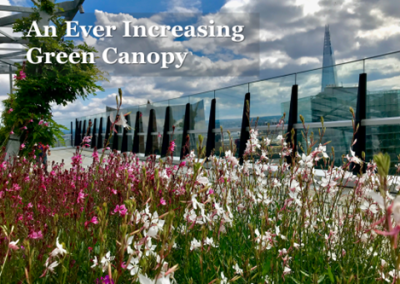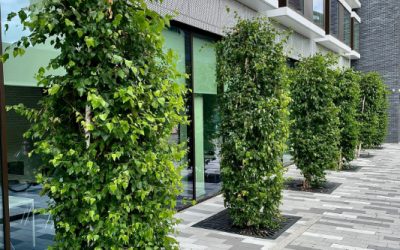Why greater urban greening makes financial as well as environmental sense.
Since the 1950’s the population of the EU (including the UK for 98% of that time) has increased by 33%, yet the total hard surface area of our cities has grown by more than double that – 78%!
I am sure we can all appreciate that as individuals, and businesses, the task of increasing or making the most of green space within our towns and cities is becoming necessary, not only for our own well-being, but also that of the planet. This is where green roofs play a vital role in urban greening.
Here at Green-tech, we are dealing with more and more green roof enquiries, which are increasingly becoming a key requirement of planning. They range from large extensive green roofs on the top of warehouses, or wildflower roofs on the roof of IKEA in Greenwich (pictured), to more adventurous intensive roof gardens that provide much needed amenity space for office workers or residents, right through to sedum roofs on cycle or bin shelters.
We are even seeing green roofs on bus shelters, and one of the rail networks is actively rolling out a programme of greening the roofs of their wheelie bin stores at several stations – turning an otherwise eye-sore into a pleasant feature that plays an important role in attracting pollinating insects and birds.
In 2017, the Greater London Authority Urban Greening Factor report stated that:
“Where possible, redevelopment and regeneration across the city should result in a greener, rather than greyer built environment.”
This puts a much greater emphasis for urban greening to be a key consideration right at the start of the development and design journey, and it doesn’t have to be just in London that this principle applies to.
So, why green roofs? Well, they are widely recognised to be one of the most effective methods of urban greening. They reduce the ecological impact of a project, creating a positive biodiversity and habitat for birds and insects. Equally important, they also provide a way of attenuating storm water, slowing it down rather than letting it gush straight down into our already overburdened sewer system. And not forgetting the visual enhancement and calming effect, all helps to create an increased sense of well-being.
Green roofs also help to offset the Urban Heat Island effect. This is where the build-up of heat held in and reflected off a city’s hard surfaces can increase the ambient temperature by up to 7°C. Roof vegetation increases the evaporation of water back into the atmosphere, which in turn has a cooling effect. The roof covering also acts as an insulator, preventing exposed roofs becoming too hot in the first place, and lessening the heat radiated back at night. The more natural cooling effect we have, the less need for carbon emitting air-conditioning units. On the flip side, they also help to keep the roofs warmer in cold weather.
These cooling and insulating benefits also give us a secondary financial bonus – less heat entering a building via its roof means less energy spent on cooling. Reduced UV radiation on the waterproofing membranes also minimises fluctuation in temperature extremes; all this helps to extend the roof’s lifespan.
Then we have the clean air effect, where the green roof vegetation absorbs carbon dioxide and releases oxygen. In addition, airborne particulates are caught by the plant leaves, then washed off by the rain to be filtered by the green roof substrate and geo-textiles, making the water entering our drain system that little bit cleaner.
And if you have a smaller area, Green-tech’s pre-grown sedum cassettes are a quick and easy way to get instant impact. They’re ideal for areas up to 40 or 50 m2
So, there are many sound reasons for having green roofs; it really doesn’t matter whether it is a purpose designed roof garden or re-purposing your utility area to make a relaxing green space for your staff; any way that we can add more green back into our environment is a move in the right direction.
Images courtesy of Dusty Gedge.







